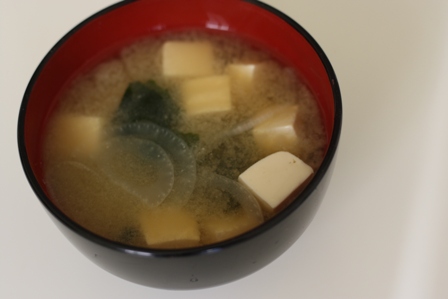 This recipe has been modified, thanks to your FEEDback
This recipe has been modified, thanks to your FEEDback
(Scroll past the recipe to see Reader ParticipATE-tion)
The soup enjoyed in sushi restaurants around the world, miso soup with tofu and wakame kelp is the standard. In Japan, however, miso soup varies with the seasons, with the type of miso paste and additions featuring what is fresh and delicious at the time (scroll down for suggestions). The only necessary staples of this recipe are the dashi stock and miso paste, leaving you to take creative license and add other ingredients to your heart’s (and your stomach’s) content.
Ingredients (per serving):
- 1 cup water
- scant ½ tsp. dashi powder
- small cubes of soft or medium-firm tofu
- 1 Tbsp. miso paste
- ¼ – ½ tsp. dried cut wakame kelp
- chopped green onions, to garnish
Method:
- Boil the dashi. Measure out one bowl’s worth of water per person you’re serving, and bring to a boil in a pot. Add a scant ½ tsp. of dashi powder (use kombu – kelp – dashi for vegans) once boiled. *Note – Dashi powders vary in strength, so check the label for more details. If it’s all written in Japanese, though, ½ tsp. per 1 cup of water usually works well.
- Add tofu. Cut tofu into small cubes and delicately place into boiling dashi. Boil until heated through (about 1 – 2 minutes).
- Add the miso paste. Measure out the miso paste into a small bowl, add a couple of tablespoons of the hot dashi, and stir vigorously until smooth. Repeat until the miso paste is thin and lump-free. Turn off the heat (over-boiling miso paste makes it clumpy and changes its flavour) and pour the thinned miso paste back into the pot of dashi.
- Serve. Put a few flakes of dried wakame kelp into an empty serving bowl and ladle in the miso soup. The wakame will reconstitute within a couple of minutes in the hot soup. Garnish with thinly sliced green onions.
Good to Know: Don’t add wakame to the pot of soup, as any leftovers will become soft and mushy. Dried wakame is best consumed immediately after it’s been reconstituted.
Miso Soup Variations:
Shiromiso Soup with Onion and Carrots
White (shiro) miso paste’s sweet and mild flavour is suited to winter vegetables like onions, carrots, and other root vegetables like daikon radish and potatoes. Thinly slice onions and carrots and, boil in dashi until soft (the onions become very sweet) and then add thinned white miso paste to finish.
Akamiso Soup with Clams
Red (aka) miso’s strong and salty flavour is prized in Japan’s summer months, when it’s often served with clams. Boil clams in dashi broth until they’ve opened (a sign that they are fully cooked) and stir in thinned akamiso paste to finish.
Awasemiso Soup with Mushrooms
Awasemiso, a mix of red and white miso, is a good all-purpose miso paste for Spring and Fall. Whether enoki, oyster, king oyster, shiitake, or even button – highlight autumn’s mushroom harvest with what is available in your area. Boil the mushrooms in dashi broth until soft, and add thinned awasemiso (or shiromiso). Garnish with laayu (chilli oil) for a little kick.
Awasemiso Soup with Usuage and Greens
Have a few leftover bits of cabbage or other greens in your fridge that threaten to turn soft and smelly? Prevent smelly fridge syndrome – throw those threatening greens into a delicious miso soup. This one uses mizuna, a sturdy Japanese green becoming popular at farmer’s markets, and thinly sliced usuage (fried tofu). Boil both lightly in dashi broth, and add thinned miso paste to finish.
Reader ParticipATE-tion:
Check out what readers have made at a FEEDback potluck.


I’d like to see a recipe for the clear soup people cook sometimes (osuimono?).